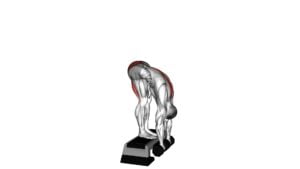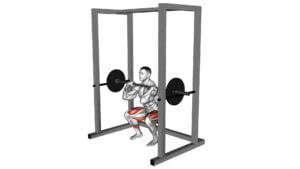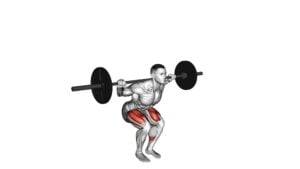Barbell Jefferson Squat – Video Exercise Guide & Tips

Looking to amp up your leg workout? Check out the Barbell Jefferson Squat! This exercise targets your quads, hamstrings, and glutes, giving you a killer lower body burn.
Watch This Exercise Video
In this video exercise guide, we'll show you the proper equipment and set-up, step-by-step execution, common mistakes to avoid, and variations to keep challenging yourself.
Get ready to maximize your results and take your leg day to the next level with the Barbell Jefferson Squat. Let's go!
Key Takeaways
- Engages multiple muscle groups simultaneously
- Allows for a deeper squat compared to traditional barbell squats
- Helps prevent injuries
- Builds lower body strength and power
Benefits of the Barbell Jefferson Squat
One benefit of the Barbell Jefferson Squat is that it engages multiple muscle groups simultaneously. This exercise is a type of unilateral training, which means that it focuses on working one side of the body at a time. This can be beneficial for several reasons.
Firstly, barbell Jefferson squat modifications allow for a deeper squat compared to traditional barbell squats. This increased range of motion targets the muscles in your glutes, hamstrings, and quadriceps more effectively. By engaging these large muscle groups, you can build strength and improve your overall lower body power.
Additionally, the unilateral nature of the Barbell Jefferson Squat helps to improve balance and stability. By isolating each leg, you can identify and address any strength imbalances or weaknesses. This can be particularly helpful for athletes who participate in sports that require lateral movements or quick changes in direction.
Furthermore, incorporating unilateral training into your workout routine can help to prevent injuries. By strengthening each leg individually, you can reduce the risk of muscle imbalances and compensate for any weaknesses. This can improve your overall performance and reduce the likelihood of overuse injuries.
Proper Equipment and Set-Up
To properly set up for the Barbell Jefferson Squat, there are a few essential pieces of equipment you'll need.
First, you'll need a barbell with weight plates that you can comfortably lift.
Additionally, you'll need a squat rack or a sturdy structure to hold the barbell at the appropriate height.
Finally, make sure to have proper footwear and a solid surface to perform the exercise on.
Essential Equipment for Setup
You will need specific equipment for proper setup of the Barbell Jefferson Squat. To perform this exercise correctly, here are the essential equipment options and steps for setting up correctly:
- Barbell:
- Choose a barbell with a suitable weight for your fitness level.
- Ensure that the barbell is securely loaded and balanced with weights on both sides.
- Squat Rack:
- Position the squat rack at an appropriate height to allow you to comfortably lift the barbell onto your shoulders.
- Adjust the safety bars of the squat rack to a height that will catch the barbell if you need to bail out of the lift.
By having the right equipment, such as a barbell and squat rack, you can ensure a safe and effective setup for the Barbell Jefferson Squat.
Remember to always prioritize your safety and choose equipment that suits your fitness level and goals.
Proper Form and Technique
To ensure proper form and technique for the Barbell Jefferson Squat, it's crucial to have the appropriate equipment and set-up in place. Using the correct form and technique not only maximizes the benefits of this exercise but also helps prevent common form mistakes.
The benefits of proper technique include targeting multiple muscle groups, increasing lower body strength and power, and improving balance and stability.
When performing the Barbell Jefferson Squat, make sure your feet are shoulder-width apart and toes pointed slightly outward. Position the barbell across your shoulders, gripping it with both hands.
Lower your body by bending at the hips and knees, keeping your back straight and chest lifted. Avoid leaning forward excessively or allowing your knees to extend beyond your toes.
Step-by-Step Execution Guide
Now it's time to focus on the execution of the Barbell Jefferson Squat.
Let's start by exploring the different foot placement options, as this will affect the muscles targeted during the exercise.
Next, we'll discuss the proper form techniques to ensure you're performing the squat correctly and maximizing its benefits.
Foot Placement Options
Begin by positioning your feet in the desired placement for the Barbell Jefferson Squat. Proper alignment is crucial to maximize the effectiveness of this exercise.
Here are two alternative techniques for foot placement:
- Narrow Stance:
- Place your feet shoulder-width apart or slightly closer.
- This technique emphasizes the quadriceps and inner thighs.
- Wide Stance:
- Position your feet wider than shoulder-width apart.
- This technique targets the glutes, hamstrings, and outer thighs.
Experiment with both techniques to find the foot placement that feels most comfortable and effective for you. Remember to maintain proper alignment throughout the exercise, keeping your knees in line with your toes and your spine neutral.
Engaging in proper foot placement will enhance the benefits of the Barbell Jefferson Squat and help you achieve your fitness goals.
Proper Form Techniques
Position your body correctly to ensure proper form and execution of the Barbell Jefferson Squat. Proper form is crucial for maximizing results and preventing injuries.
Here are some common errors to avoid and injury prevention techniques to keep in mind:
- Common errors:
- Avoid rounding your back or hunching your shoulders. Keep your spine neutral and engage your core throughout the movement.
- Don't let your knees collapse inward. Keep them aligned with your toes to maintain stability and prevent strain on your joints.
- Avoid leaning too far forward or backward. Maintain a balanced position throughout the exercise.
- Injury prevention techniques:
- Warm up properly before starting the exercise to increase blood flow and prepare your muscles for the workout.
- Use appropriate weights that challenge you without compromising your form.
- Focus on maintaining control and stability throughout the movement, rather than rushing through it.
Muscles Targeted During Exercise
To effectively target and engage specific muscles during the Barbell Jefferson Squat, focus on maintaining proper form and execution. This exercise primarily targets the lower body, including the quadriceps, glutes, hamstrings, and calves. Additionally, it also engages the core muscles for stability and balance.
Here is a breakdown of the targeted muscles and their activation during the Barbell Jefferson Squat:
- Quadriceps: The quadriceps, located in the front of the thigh, are the primary muscles targeted in this exercise. They're activated as you lower your body down into the squatting position and push back up to the starting position.
- Glutes: The glutes, consisting of the gluteus maximus, medius, and minimus, are activated as you drive your hips forward and extend the knees during the upward phase of the exercise.
- Hamstrings: The hamstrings, located at the back of the thigh, are engaged as you bend your knees and lower your body down into the squat.
- Calves: The calf muscles are activated as you push through the balls of your feet to rise up from the squatting position.
Common Mistakes to Avoid
To avoid common mistakes while performing the Barbell Jefferson Squat, make sure that you maintain proper form and technique throughout the exercise.
One common mistake to avoid is rounding your back. It's crucial to keep your spine in a neutral position and avoid any excessive curvature. Rounding your back not only puts unnecessary stress on your spine but also takes away from the effectiveness of the exercise.
Another mistake to watch out for is allowing your knees to cave inwards. This can happen when you don't engage your glutes and hip muscles properly. To avoid this, focus on pushing your knees outwards as you squat down.
It's also important to maintain a stable and balanced position throughout the movement. Avoid leaning too far forward or backward, as this can throw off your balance and increase the risk of injury.
Lastly, make sure to use an appropriate weight for your fitness level. Using too heavy of a weight can compromise your form and lead to improper technique.
Variations and Progressions
Try incorporating different variations and progressions of the Barbell Jefferson Squat to challenge your muscles and continue making progress in your strength training routine. Here are some progression variations and advanced modifications you can try:
- Front Rack Jefferson Squat: Instead of holding the barbell at your sides, bring it up to the front rack position, resting on your shoulders. This variation will engage your core and upper body more, while still targeting your lower body muscles.
- Single-Leg Jefferson Squat: Elevate one foot on a step or platform behind you and perform the squat on the opposite leg. This variation increases the challenge on your stabilizing muscles and can help improve balance and coordination.
- Barbell Jefferson Jump Squat: Once you have mastered the basic Jefferson Squat, add an explosive jump at the top of the movement. This advanced modification will increase power and explosiveness in your lower body.
By incorporating these progression variations and advanced modifications into your routine, you can continuously challenge your muscles and avoid plateauing. These variations will target different muscle groups and add variety to your workouts, keeping you motivated and engaged.
Now that you have learned about the variations and progressions of the Barbell Jefferson Squat, let's move on to the next section to learn some tips for maximizing your results.
Tips for Maximizing Your Results
Focus on maintaining proper form and gradually increasing the weight to maximize your results with the Barbell Jefferson Squat. To make the most out of your training, it's important to be aware of common misconceptions and adopt effective training strategies.
One common misconception is that more weight equals better results. While increasing the weight is important for progress, it's crucial to prioritize proper form over the amount of weight lifted. Focus on executing each rep with correct technique, ensuring that your knees are aligned with your toes, your back is straight, and your core is engaged. This won't only prevent injuries but also target the muscles more effectively.
In addition to form, effective training strategies can greatly impact your results. Incorporating progressive overload is key. Gradually increase the weight or the number of repetitions over time to challenge your muscles and promote strength gains. This progressive approach will prevent plateaus and continuously stimulate muscle growth.
Furthermore, don't forget to prioritize recovery. Allow adequate rest days between training sessions to give your muscles time to repair and grow stronger. Adequate sleep, proper nutrition, and hydration also play a crucial role in maximizing your results.
Frequently Asked Questions
Can the Barbell Jefferson Squat Be Performed by Beginners?
Yes, you can definitely perform the barbell Jefferson squat as a beginner. This exercise can be modified to suit your fitness level by using lighter weights or even just your body weight.
The barbell Jefferson squat is a great exercise for strength training as it targets multiple muscle groups, including the quads, hamstrings, glutes, and core.
It can help improve your lower body strength, stability, and overall athletic performance.
Give it a try and start reaping the benefits!
What Is the Difference Between a Barbell Jefferson Squat and a Regular Barbell Squat?
The difference between a barbell Jefferson squat and a regular barbell squat is the position of your feet. In a regular squat, your feet are parallel or slightly turned out. But in a Jefferson squat, one foot is in front and the other is behind, with a wider stance.
This variation targets your quads, glutes, and hamstrings in a different way, providing unique benefits such as increased hip mobility and stability.
To properly perform a barbell Jefferson squat, follow these steps…
Can the Barbell Jefferson Squat Help Improve Flexibility?
The barbell Jefferson squat is a great exercise for improving hip mobility and flexibility. By incorporating this exercise into your routine, you can target each leg individually and work on any imbalances or weaknesses.
This unilateral training can help enhance your overall stability and strength. Additionally, the barbell Jefferson squat offers the added benefit of stretching and opening up your hips, which can improve your range of motion and prevent injuries.
How Often Should the Barbell Jefferson Squat Be Performed for Optimal Results?
To achieve optimal results with the barbell Jefferson squat, it's important to consider the optimal frequency of performing the exercise.
By incorporating this variation into your training routine, you can enhance your lower body strength and flexibility.
Beginners can start by performing the exercise once or twice a week, gradually increasing the frequency as they become more comfortable and experienced.
Remember to listen to your body and adjust the frequency accordingly to avoid overtraining or injury.
Are There Any Specific Warm-Up Exercises Recommended Before Performing the Barbell Jefferson Squat?
Before performing the Barbell Jefferson Squat, it's important to do a dynamic warm-up to get your body ready for the exercise. This can include exercises like jumping jacks, high knees, or leg swings.
Additionally, incorporating mobility exercises like hip circles or ankle rotations can help improve your range of motion and prevent injury.
Conclusion
Incorporating the Barbell Jefferson Squat into your workout routine can provide numerous benefits, such as improving lower body strength and stability. By following proper equipment set-up and execution techniques, you can maximize your results and avoid common mistakes.
Additionally, exploring variations and progressions of the exercise can add variety and challenge to your workouts. Remember to always prioritize proper form and listen to your body to ensure a safe and effective workout.
Get ready to take your squat game to the next level!

Author
Years ago, the spark of my life’s passion ignited in my mind the moment I stepped into the local gym for the first time. The inaugural bead of perspiration, the initial endeavor, the very first surge of endorphins, and a sense of pride that washed over me post-workout marked the beginning of my deep-seated interest in strength sports, fitness, and sports nutrition. This very curiosity blossomed rapidly into a profound fascination, propelling me to earn a Master’s degree in Physical Education from the Academy of Physical Education in Krakow, followed by a Sports Manager diploma from the Jagiellonian University. My journey of growth led me to gain more specialized qualifications, such as being a certified personal trainer with a focus on sports dietetics, a lifeguard, and an instructor for wellness and corrective gymnastics. Theoretical knowledge paired seamlessly with practical experience, reinforcing my belief that the transformation of individuals under my guidance was also a reflection of my personal growth. This belief holds true even today. Each day, I strive to push the boundaries and explore new realms. These realms gently elevate me to greater heights. The unique combination of passion for my field and the continuous quest for growth fuels my drive to break new ground.







